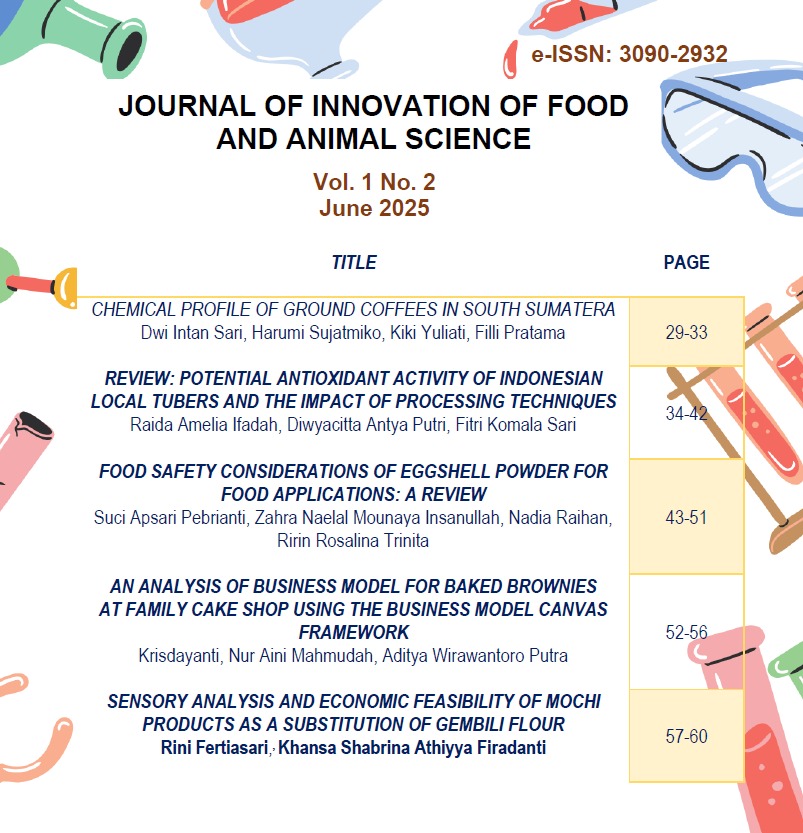AN ANALYSIS OF BUSINESS MODEL FOR BAKED BROWNIES AT FAMILY CAKE SHOP USING THE BUSINESS MODEL CANVAS FRAMEWORK
 Abstract views: 231
,
Abstract views: 231
,
 PDF downloads: 113
PDF downloads: 113
Abstract
This study aims to analyze the business model of baked brownies at Family Cake Shop using the Business Model Canvas (BMC) framework. As a growing family-owned bakery located in Blitar, East Java, Family Cake Shop offers a variety of pastry products, with baked brownies as one of its flagship items. The research employed a qualitative descriptive approach, collecting data through semi-structured interviews and direct observation. The BMC framework was utilized to examine nine core elements of the business model, including customer segments, value propositions, channels, customer relationships, revenue streams, key resources, key activities, key partnerships, and cost structure. The analysis revealed that the shop targets a broad customer base, ranging from children and students to working professionals. Its value proposition centers on the use of locally sourced cocoa, halal certification, and a registered trademark “Locita.” Distribution is carried out through physical stores, delivery services, and partner souvenir outlets. Strong customer relationships are maintained through communication, feedback, and loyalty incentives. The shop's revenue relies on diverse selling platforms, supported by skilled labor, essential baking equipment, and strategic location. Core activities include production, distribution, and marketing, while key partnerships ensure a stable supply of ingredients. The cost structure is dominated by raw material purchases and operational expenses. The findings suggest that BMC is an effective analytical tool for evaluating and optimizing small-scale bakery businesses. This study provides practical insights for improving strategic planning and enhancing the competitiveness of culinary business.
References
Badan Pusat Statistik. 2020. Statistik Ekonomi Kreatif 2020. Jakarta: BPS. [Online] https://www.bps.go.id/id/publication/2020/04/29/e9011b3155d45d70823c141f/statistik-indonesia-2020.html
Braun, V. and Clarke, V. 2006. Using thematic analysis in psychology. Qualitative Research in Psychology, 3 (2). pp. 77-101. ISSN: 1478-088.
Fizriani, A., Putri, N. E., dan Triandita, N. 2019. Sifat Kimia dan Sensori Brownies Berbahan Baku Tepung Mocaf, Jagung dan Kedelai Hitam. Food Tech: Jurnal Teknologi Pangan, 2(2), 24-34.
Hassan, A. 2012. The value proposition concept in marketing: how customers perceive the value delivered by firms– a study of customer perspectives on supermarkets in southampton in the united kingdom. International Journal of Marketing Studies, 4, 68-68. https://doi.org/10.5539/ijms.v4n3p68
Murray, A. & Scuotto, V. 2015. The Business Model Canvas. Symphonya. Emerging Issues in Management, 94, https://doi.org/10.4468/2015.3.13murray.scuotto
Mutambik, I. 2024. The role of strategic partnerships and digital transformation in enhancing supply chain agility and performance. Systems, 12(456). https://doi.org/10.3390/systems12110456
Rahman, W., Launtu, A., Ohara, M., Asir, M., Mere, K. 2025. Omnichannel marketing strategies: bridging the gap between online and offline consumer experiences. Journal of Economic, Bussines and Accounting (COSTING), 8, 953-959. https://doi.org/10.31539/costing.v8i2.14550
Rane, N.L., Achari, A., Choudhary, S. 2023. Enhancing customer loyalty through quality of service: fffective strategies to improve customer satisfaction, experience, relationship, and engagement. International Research Journal of Modernization in Engineering Technology and Science, 5, 427-452. https://doi.org/10.56726/IRJMETS38104
Remeňová, K., Kintler, J., Jankelova, N. 2020. The General Concept of the Revenue Model for Sustainability Growth. Sustainability. 12. 6635. https://doi.org/10.3390/su12166635
Sumarwan, U. 2013. Proses Konsumsi dan Kepuasan terhadap Produk Bakery. Bakery Magazine, 3(6), 104-106.
Taufiqulloh, R., Pasaribu, R.D. 2023. Improving Business Model Canvas (BMC) with The Approach of Strength, Weakness, Opportunity and Threat Factors at Seymour Business Unit. Journal of Humanities and Social Studies, 07(03), 849-854.
Wahab, M.H.A.A., Ismail, M., Muhayiddin, M.N. 2020. Critical success factors of operational excellence practices for manufacturing industry. International Journal of Business Performance and Supply Chain Modelling, 11(358), https://doi.org/10.1504/IJBPSCM.2020.112731
Wang, H., Zhang, L., Xu, D. 2025. Breakthrough technological innovation, market competition, and corporate competitive advantage. Finance Research Letters, 76. https://doi.org/10.1016/j.frl.2025.107030
Wijayanti, N. & Hidayat, H.H. (2020). Model business canvas (bmc) sebagai strategi penguatan kompetensi UMKM makanan ringan di Kabupaten Kebumen, Jawa Tengah. Jurnal Agroindustri Halal, 6(2), 2442-3548



